Hewlett Packard Enterprise WL464 Bridging kit - 802.11a User Manual WL 464 manual 0613
Hewlett-Packard Company Bridging kit - 802.11a WL 464 manual 0613
Contents
- 1. User manual
- 2. user Manual
User manual
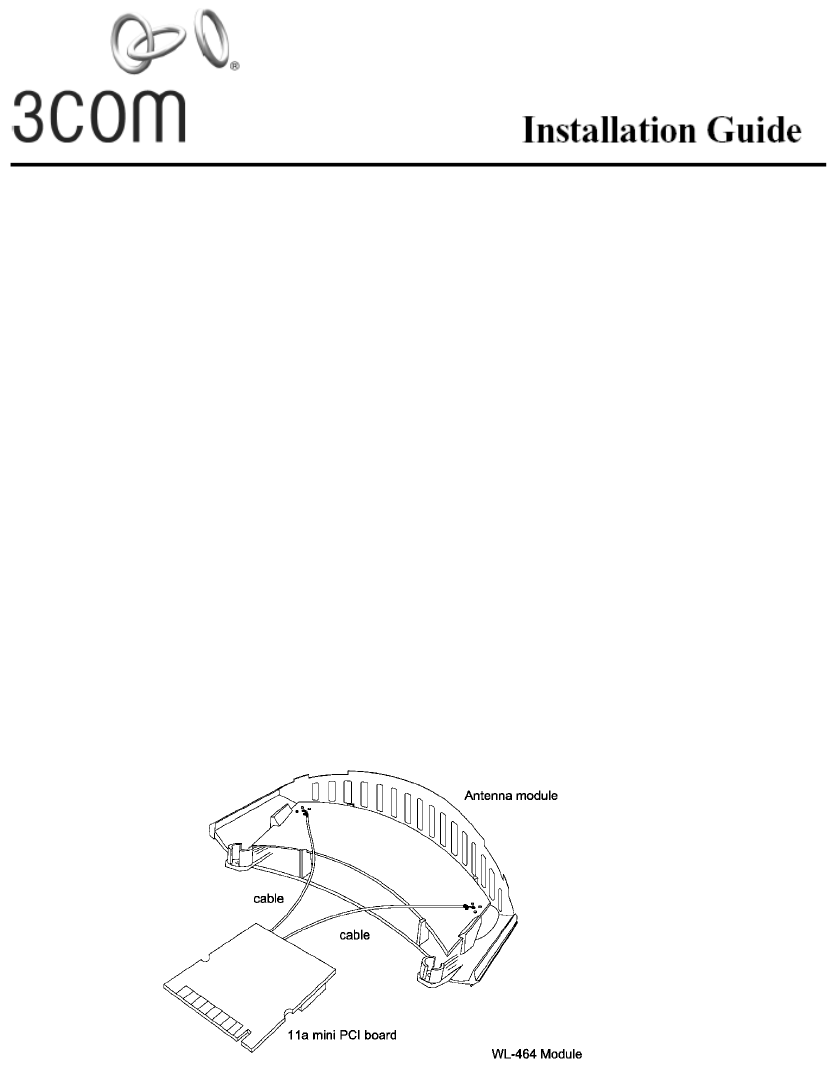
802.11a mini-PCI Radio Module
MODEL WL-464
The 3Com 802.11a mini-PCI Radio Module Kit contains everything you need to install an additional radio
and antenna into your 3Com Access Point.
Kit Contents
The upgrade kit contains these items:
• One antenna module
• One 802.11a mini-PCI Radio Module
• Two cables connect the antenna module and mini PCI card by direct soldering.
1 Detach and disconnect the access point
If the access point is mounted on the wall, turn the unit counterclockwise to disengage it from the mounting
plate. Disconnect the Ethernet cable. Place the access point face down on a static-free surface.
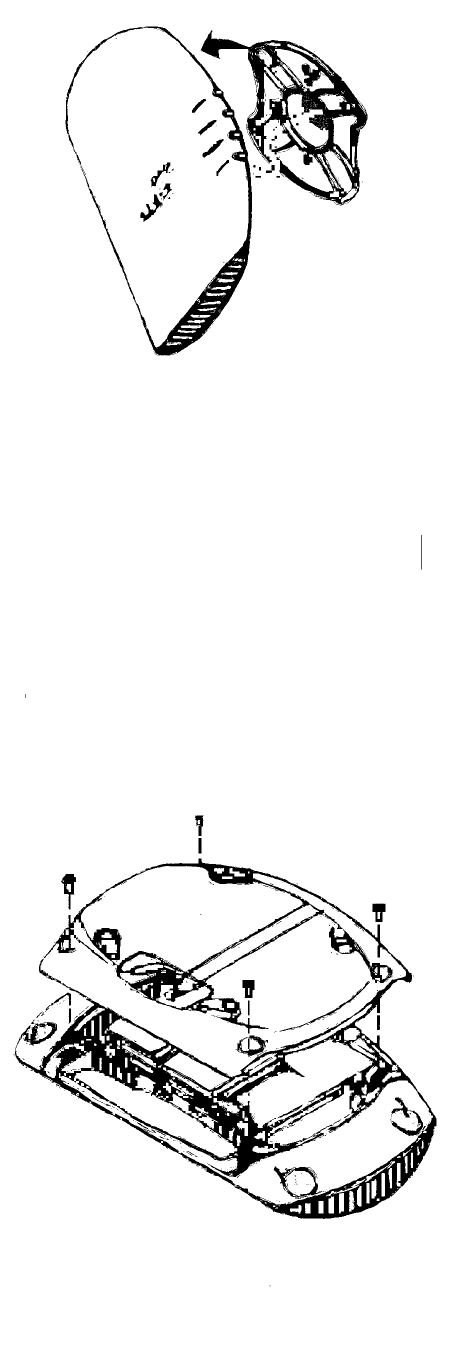
2 Remove the back cover
Using a cross-tip screwdriver, remove the four screws from the back cover. Remove the cover from the unit.
Set the cover and screws aside.
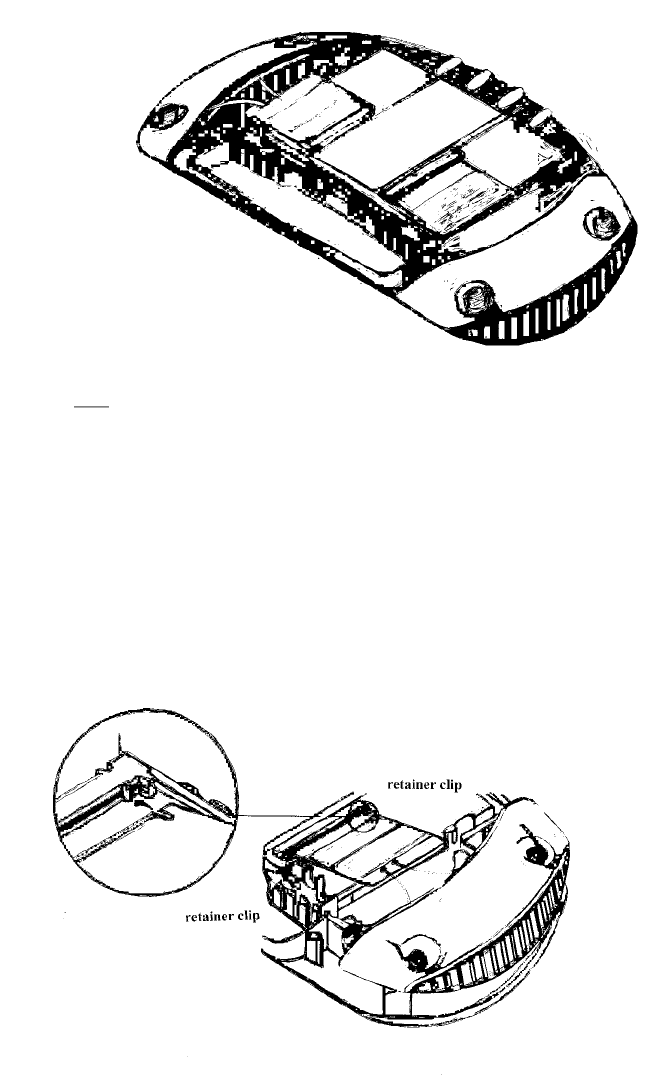
3 Remove the antenna housing.
Grasp the inside edge of the antenna housing and pull up to disengage the housing from the unit, as
shown below. This part is no longer needed.
4 Install the 11a upgrade kit.
4.1. 11a mini PCI card side:
Holding the radio board at an angle, align the contact edge with the mini PCI connector
on the unit. Make sure the keying notch on the contact edge line up with the key on the
connector, as shown in the detail below. Slide the board into the connector and press
down gently until the two retainer clips snap into place.
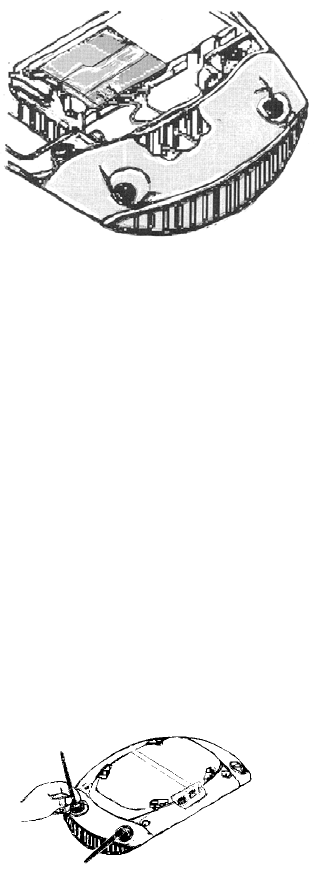
4.2. Antenna module side:
1 Align the antenna module with the snaps and posts on the unit and press until the
module snaps firmly into place.
2 Align the cables to be routed through the slots in the unit.
3 After the cables are aligned, press them down out of the way inside the housing.
5 Replace the back cover.
Make sure that the cables are tucked away inside the housing so that they do not obstruct
the cover. Align the back cover with the unit and settle the cover into place. Tighten the
four screw.
6 Attach the antennas.
Being careful not to touch the antenna tips, screw the antennas onto the SMA connectors
and hand tighten them. After network startup , you may need to adjust the antennas to
fine tune radio coverage.
7 Reinstall the access point.
Reconnect the Ethernet cable and reattach the access point to the wall mounting plate.
Adjust the antennas to improve the radio signal, if necessary.
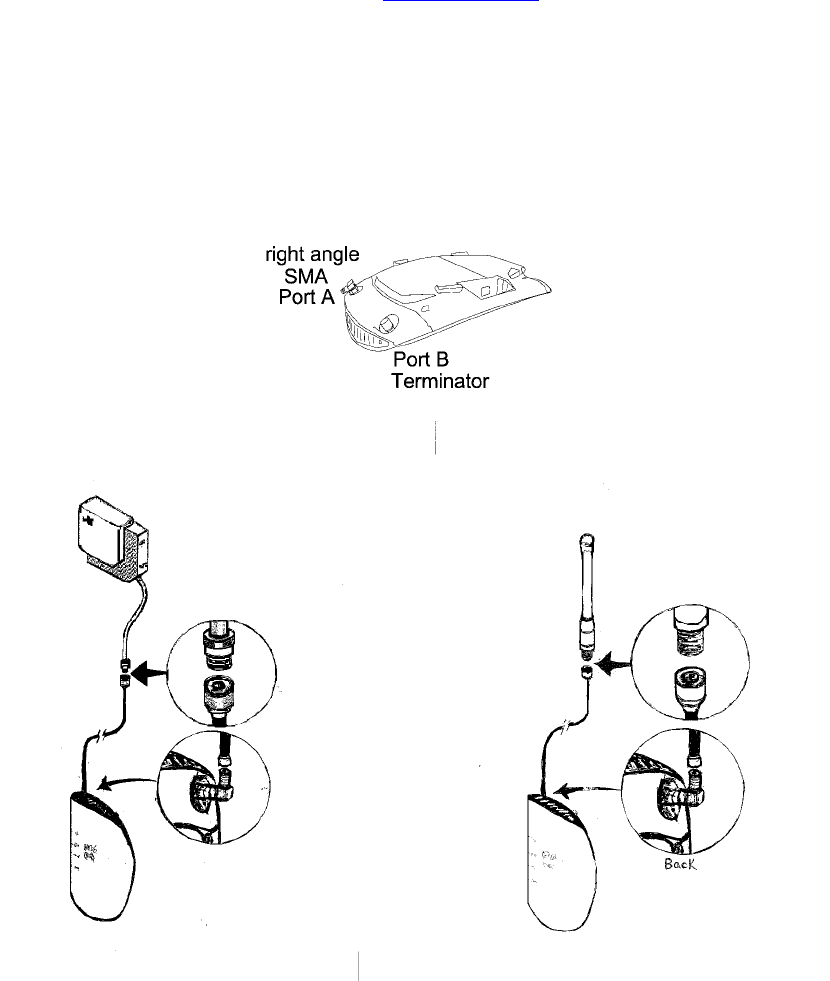
SELECTING AND CONNECTING A DIFFERENT
ANTENNA MODEL
The standard detachable antennas supplied with the WL-464 11a mini-PCI radio module and are suitable
for a broad variety of environments. If you require a different type of antenna several options are available
by model number from the 3Com Web site(www.3Com.ccom).
For each of the antenna models, you will need either a 6-foot accessory cable (model 3CWE480), a 20-foot
accessory cable (model 3CWE481), or a 50-foot accessory cable (model 3CWE482) to provide the
transition from the SMA connector on the access point to the N-type connector on the antenna. To ensure
the physical safety of anyone near the antenna and to prevent damage to the access point, follow the
building code for antenna installations in your area. Also, when connecting the optional antenna to the
access point, remember to use only the A-side connector on the access point, on the right when properly
installed. B-side install a terminator at the same time.
1 Position the antenna so that there are minimal obstacles between it and any client with which it will
communicate. While maintaining a direct line of sight between the antenna and a client is not strictly
necessary, such an arrangement helps to ensure a strong signal. Ensure that access is available for
routing the antenna cable from the antenna to the access point.
2 If they are installed, remove both arms of standard detachable antenna, making sure not to handle the
tips of antenna.
3 Connect one end of the optional antenna cable to the antenna and secure the antenna in place.
4 Connect the free end of the antenna cable to the right-hand side connection on the access point, as
shown in the illustration above.
5 Make certain that the antennas and antenna masts are appropriately ground to prevent injury or
damage from lightning strikes.
Regulatory Compliance Information
3Com 802.11a Wireless LAN Access Point Upgrade Kit
Federal Communication Commission Interference Statement
This equipment has been tested and found to comply with the limits for a Class B digital
device, pursuant to Part 15 of the FCC Rules. These limits are designed to provide
reasonable protection against harmful interference in a residential installation. This
equipment generates, uses and can radiate radio frequency energy and, if not installed
and used in accordance with the instructions, may cause harmful interference to radio
communications. However, there is no guarantee that interference will not occur in a
particular installation. If this equipment does cause harmful interference to radio or
television reception, which can be determined by turning the equipment off and on, the
user is encouraged to try to correct the interference by one of the following measures:
- Reorient or relocate the receiving antenna.
- Increase the separation between the equipment and receiver.
- Connect the equipment into an outlet on a circuit different from that
to which the receiver is connected.
- Consult the dealer or an experienced radio/TV technician for help.
This device complies with Part 15 of the FCC Rules. Operation is subject to the following
two conditions: (1) This device may not cause harmful interference, and (2) this device
must accept any interference received, including interference that may cause undesired
operation.
FCC Caution: Any changes or modifications not expressly approved by the party
responsible for compliance could void the user's authority to operate this equipment.
IMPORTANT NOTE:
FCC Radiation Exposure Statement:
This equipment complies with FCC radiation exposure limits set forth for an uncontrolled
environment. This equipment should be installed and operated with minimum distance 30cm
between the radiator & your body.
This transmitter must not be co-located or operating in conjunction with any other antenna or
transmitter.
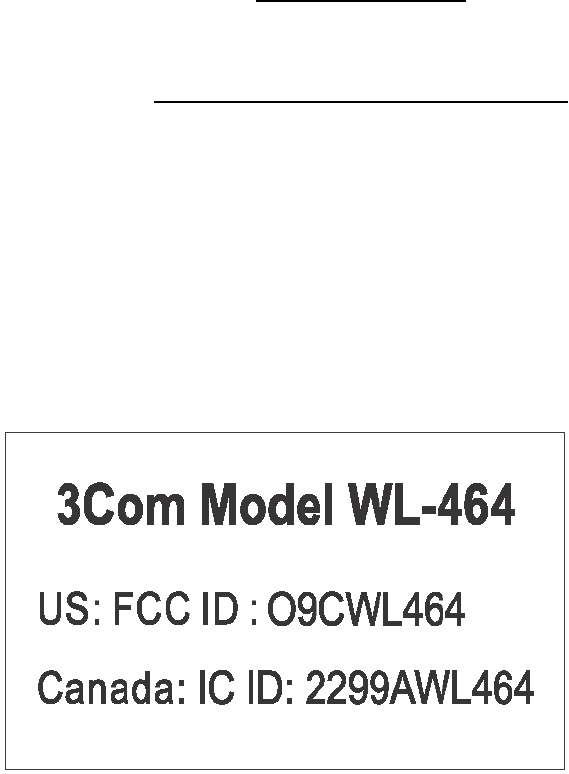
This device is intended only for OEM integrators under the following condition - The
antenna must be installed such that 30 cm is maintained between the antenna and users.
As long as the condition above is met, further transmitter test will not be required. However, the
OEM integrator is still responsible for testing their end-product for any additional compliance
requirements required with this module installed (for example, digital device emissions, PC
peripheral requirements, etc.).
IMPORTANT NOTE: In the event that these conditions can not be met (for example certain laptop
configurations or co-location with another transmitter), then the FCC authorization is no longer
considered valid and the FCC ID can not be used on the final product. In these circumstances, the
OEM integrator will be responsible for re-evaluating the end product (including the transmitter)
and obtaining a separate FCC authorization.
End Product Labeling
This transmitter module is authorized only for use in device where the antenna may be installed
such that 30 cm may be maintained between the antenna and users. The final end product must
be labeled in a visible area with the following: “Contains TX FCC ID: O9CWL464”.
Manual Information That Must be Included
The OEM integrator has to be aware not to provide information to the end user regarding how to
install or remove this RF module in the users manual of the end product which integrate this
module.
The users manual for end users must include the following information in a prominent location
“ IMPORTANT NOTE: To comply with FCC RF exposure compliance requirements, the antenna
used for this transmitter must be installed to provide a separation distance of at least 30 cm from
all persons and must not be co-located or operating in conjunction with any other antenna or
transmitter”.
If the end product integrating this module is going to be operated in 5.15 ~ 5.25GHz frequency
range, the warning statement in the user manual of the end product should include the restriction
of operating this device in indoor could void the user’s authority to operate the equipment.
Industry Canada Statement
Operation is subject to the following two conditions:
1) this device may not cause interference and
2) this device must accept any interference, including interference that may cause undesired
operation of the device
This device has been designed to operate with an antenna having a maximum gain of 8 dB.
Antenna having a higher gain is strictly prohibited per regulations of Industry Canada. The
required antenna
impedance is 50 ohms.
To reduce potential radio interference to other users, the antenna type and its gain should be so
chosen that the EIRP is not more than required for successful communication.
